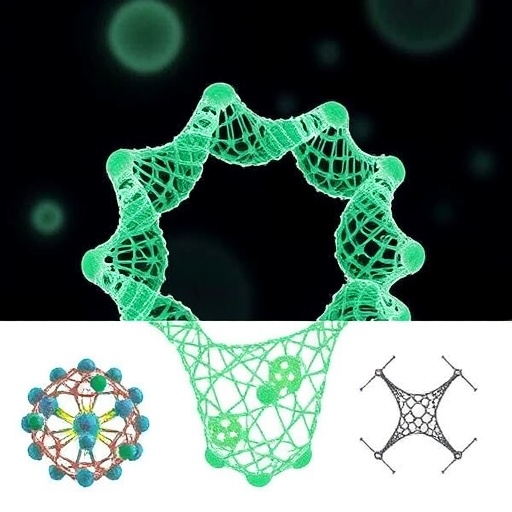In the ever-evolving realm of environmental science, the degradation of pharmaceuticals remains a significant area of concern. Researchers are constantly on the lookout for effective methods to manage and eliminate pollutants that pose risks to ecosystems and public health. A recent study conducted by Varghese et al. introduces groundbreaking advancements in this field by exploring the enhanced photocatalytic degradation of two widely used antibiotics: tetracycline and ciprofloxacin. These compounds, while beneficial in clinical settings, are notorious for their persistent environmental presence and potential deleterious effects on aquatic life and human health.
The study focuses on the development and application of a novel nanocomposite consisting of cobalt ferrite (CoFe2O4) and multi-walled carbon nanotubes (MWCNTs). This composite technology is touted for its enhanced photocatalytic properties that significantly improve the degradation rates of the targeted antibiotics under UV light exposure. The researchers assert that employing CoFe2O4/MWCNTs not only accelerates the breakdown of these pharmaceuticals but also, importantly, demonstrates a remarkable capacity to reduce toxicity, marking a pivotal step towards innovative environmental remediation techniques.
Photocatalysis, as a process, relies on light energy to activate a catalyst, which subsequently facilitates the breakdown of organic pollutants into harmless substances. Traditional photocatalysts often suffer from limitations such as low efficiency and limited light absorption. The CoFe2O4/MWCNTs composite combines the magnetic properties of cobalt ferrite with the exceptional conductivity and high surface area of MWCNTs, creating a composite that significantly enhances light absorption and improves charge separation. This synergistic effect is a cornerstone of the study’s findings, showcasing the potential of engineered nanocomposites in environmental applications.
In their testing, the researchers subjected the CoFe2O4/MWCNTs composite to varying concentrations of tetracycline and ciprofloxacin. The results were nothing short of impressive; the composite achieved near-complete degradation of both antibiotics within a remarkably short time frame when exposed to UV light. This efficiency surpassed many traditional photocatalysts previously documented in literature, solidifying the composite’s place as a leading candidate for pharmaceutical remediation.
In addition to assessing degradation efficiency, Varghese and colleagues also explored the recyclability of the CoFe2O4/MWCNTs composite. The ability to reuse materials in environmental applications greatly enhances their sustainability and practicality. Following several cycles of photocatalytic degradation, the composite retained a significant portion of its activity. This durability not only contributes to cost-effectiveness but also aligns with the growing emphasis on sustainable practices in industrial applications.
The study further delves into the mechanisms underpinning the photocatalytic process. Varghese et al. employed advanced analytical techniques to track the formation of reactive species that play a crucial role in the degradation of pollutants. Hydroxyl radicals (•OH) and superoxide anions are particularly noteworthy in this context, as they are incredibly reactive and capable of oxidizing a wide range of organic compounds. The team’s findings suggest that the CoFe2O4/MWCNTs composite generates these radicals efficiently, facilitating the breakdown of the antibiotics into non-toxic intermediates.
Moreover, the environmental implications of the study extend beyond mere degradation rates. The research highlights the need for viable wastewater treatment technologies that can be integrated into existing systems. As cities and industries grapple with the influx of pharmaceuticals in water supplies, the development of efficient treatment methods becomes imperative. Solutions like the one proposed by Varghese et al. offer a promising avenue for addressing these challenges, especially in regions where traditional wastewater treatment facilities struggle to meet regulatory standards.
As the world increasingly recognizes the impact of pharmaceutical contamination on aquatic environments, this research could usher in a new era of more effective pollution management strategies. The authors call for further exploration into the full-scale application of their findings, advocating that combining cutting-edge nanotechnology with environmental science could yield transformative results.
The study has garnered considerable attention not just for its innovative approach but also for the broader implications regarding nanotechnology in environmental remediation. As public awareness of pollution issues grows, so too does the responsibility of scientists and researchers to develop solutions that mitigate these challenges. This research effectively highlights the potential of nanocomposites in addressing one of the most pressing issues of our time: the pervasive impact of pharmaceuticals on ecosystems.
In conclusion, Varghese et al.’s work opens the door to numerous further investigations. Future studies could look into the long-term effects of using CoFe2O4/MWCNTs composites in various environmental settings. Additionally, understanding how these technology systems perform under real-world conditions would be essential for translating laboratory successes into feasible field applications. The fight against pharmaceutical pollution may be significantly bolstered by these findings, setting a precedent for future research in the field.
As environmental challenges grow more complex, interdisciplinary approaches such as this one will be vital in crafting effective solutions. The marriage between nanotechnology and environmental science, as evidenced by this study, is not only timely but also necessary in fostering sustainability for future generations. The road ahead is clear; innovation in research must continue to shine light on the path toward cleaner, healthier ecosystems through enhanced technologies.
Subject of Research: Enhanced photocatalytic degradation of pharmaceuticals in wastewater through nanocomposite technology.
Article Title: Enhanced Photocatalytic Degradation of Tetracycline and Ciprofloxacin Using CoFe2O4/MWCNTs Nanocomposite: A Comparative Efficiency Analysis.
Article References:
Varghese, D., Niranjana, S.R., Muthupandi, S. et al. Enhanced Photocatalytic Degradation of Tetracycline and Ciprofloxacin Using CoFe2O4/MWCNTs Nanocomposite: A Comparative Efficiency Analysis.
Waste Biomass Valor (2025). https://doi.org/10.1007/s12649-025-03389-8
Image Credits: AI Generated
DOI: https://doi.org/10.1007/s12649-025-03389-8
Keywords: Nanocomposite, Photocatalysis, Tetracycline, Ciprofloxacin, Environmental Remediation, Cobalt Ferrite, Multi-walled Carbon Nanotubes.




